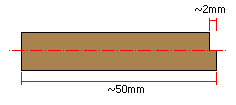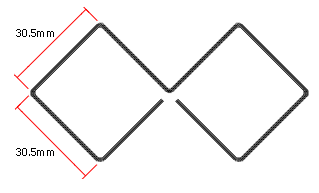|
|
|
|
|
|
Biquad Antenna Construction
This
page details the construction of a biquad, originally intended
to be used as a feed for a 24dBi Conifer dish, but I found it
works very well by itself.
Background
I've done quite a bit
of experimentation and testing with various homemade
dipoles for 24dBi Conifer dishes, and have managed to increase
the signal strength.
Trevor
Marshall has a webpage with information about using a
biquad as a feed on a Primestar satellite dish, with very good
results. I decided to try using a biquad as a feed on a 24dBi
Conifer dish, to see if I could improve the performance of it.
Note that the photos on Trevor Marshall's webpage do not clearly show the construction
of the biquad - particularly the way in which the quad is
attached to the coax. Numerous people (including myself) have
constructed biquads incorrectly, based on his photos, and
found that they perform very poorly.
Use the photos of my
biquad below, and refer to the websites listed in the references
section at the bottom of this page for more information on the
correct construction of the biquad.
Parts Required
I used the following bits and pieces:
-110x110mm square section of blank
PCB
-50mm length of 1/2" copper
pipe
-short length of CNT-400 low
loss coax (~300mm long)
-1.5mm
copper wire
-N connector
Reflector
Cut a square piece of
blank printed circuit board, 110x110mm.
Note that Trevor Marshall recommends a size of
123x123mm if using the biquad as a stand-alone antenna, while
110x110 is optimal if using it as a feed for a large dish.
He also recommends attaching some lips to two sides of the
reflector, to reduce radiation from the rear lobes.
Use some steel wool to remove any tarnish and polish
it up. Cleaning the copper in this way will make it easier to
solder.

blank printed circuit
board
Cut a 50mm section of copper pipe,
and file both ends smooth. Using some sandpaper and/or some
files, polish up the copper pipe (including the inside of the
copper pipe, to ensure a good connection with the coax braid).

the dimensions of the copper
pipe
Cut a notch into one end of the
copper pipe, removing approx 2mm from half the circumference.

a short secion of copper
pipe, notched at one end
Drill a hole in
the centre of the blank PCB so that the copper pipe is a tight
fit in the hole. I found a reamer to be very useful for
enlarging the hole to the correct size.

making a hole in the
centre
Insert the copper pipe into the
hole, with the notched end on the copper side of the blank
PCB. The copper pipe should be protruding approx 16mm through
the hole, measured on the copper side of the PCB.

insert the copper pipe
into the reflector
Solder the copper pipe
to the PCB, to ensure a good physical and electrical
connection.

solder the copper pipe
to the PCB Quite a bit of heat is needed, due
to the thickness of the copper pipe, and an electrical
soldering iron probably won't be able to deliver sufficent
heat. I found a small gas torch works quite well.
Making the
Quad
The quad is made from a length of copper wire,
bent into the appropriate shape.
Note that the length
of each "side" should be as close to 30.5mm as possible
(measured from the centre of the copper wire to the centre of
the copper wire), which is a quarter of a wavelength at 2.4GHz

the shape and dimensions of
the biquad
I had some offcuts of power
cable lying around, and found that 2.5mm^2 power cable had a
diameter of approx 1.6mm - a little bigger than the 1.2mm that
Trevor Marshall specifies, but didn't think it would make a
significant difference to the performance of the biquad.

recycling power cable
offcuts
Remove the insulation, measure and
cut a 244mm length the copper wire, and straighten it as best
as you can.

straighten the
wire
Measure the mid-point of the wire,
and make a 90 degree bend. The bend should be quite sharp and
pronounced.

90 degree bend
Measure the midpoints of each half, and make two
more 90 degree bends in the wire, so that it looks like that
shown in the photo below.

another two bends
Once again, measure the midpoints of each
section, and make some more 90 degree bends, resulting in what
is shown below.

bend it some
more...
Do the same to the other side,
resulting in the biquad shape.

make it
symetrical...
Clean up all your bends, and
ensure each side of the quad is as straight as possible, and
as close to 30.5mm as possible.
Note that you may need to
trim a small amount off each end of the wire to achieve this.
Assembly
The quad must now be
attached to the reflector. Note that only the two "ends" of
the copper wire are to be attached to the copper pipe - the
centre of the copper wire must not touch the copper pipe
(hence the notch which was cut into the end of the copper
pipe.
The copper wire should be approximately 15mm away
from the reflector.

the quad soldered onto
the copper pipe
Strip approx 30mm of the
outer sheath from the end of the coax.

strip the outer
sheath
Fold the braid back over the outer
sheath, and trim the centre conductor, so that about 4mm is
protruding.

fold the braid back,
trim the centre conductor
Insert the braid
into the copper pipe, so that the end of the centre conductor
lines up with the extreme end of the copper pipe, and solder
the centre of the quad to it, ensuring the centre of the quad
is not contacting with the copper pipe. Refer to some of the
additional photos below for details.

solder the centre
conductor to the quad

another view
I used a coax crimper to crimp the end of the
copper pipe onto the coax. This ensures that the coax would
not move inside the copper pipe.

the copper pipe crimped
onto the coax

the completed
biquad
Now it's time to terminate the coax
with an N connector, and do some testing. If you intend to
mount the biquad outside, I'd recommend you place it into a
weather proof enclosure. Numerous people have used small
tuppaware containers successfully.

another view of the
completed biquad
Testing
Some very rough initial testing using the biquad as a feed
on a 24dBi Conifer dish looks very promising, with the signal
strength being at least as as good as my homemade
Conifer dipole (I was holding the biquad at approximately the
focal point of the dish, and hadn't even removed the Conifer
dipole).
I also managed to get a marginal link to an
access point 10km distant, using only the biquad by itself!
Update: some more testing
has been undertaken, with the biquads recording a gain of
approx 10-12dBi
References
Trevor Marshall's BiQuad 802.11b Antenna
Simple Double-Quad Antenna
Reseau
Citoyen: BiQuad
Lincomatic's Homebrew WiFi Antennae
last updated 2 Dec
2003
|
| |
|
|
|
|
|
|

